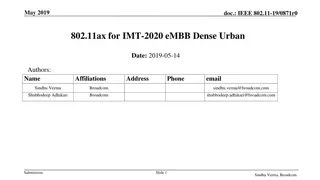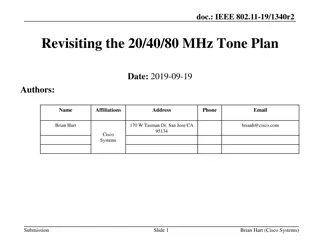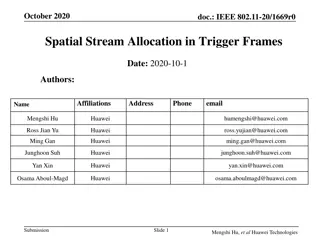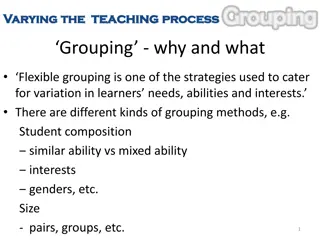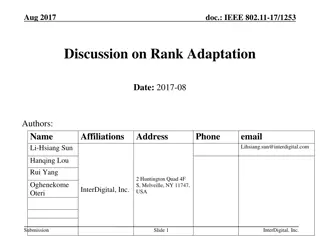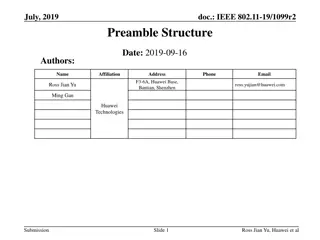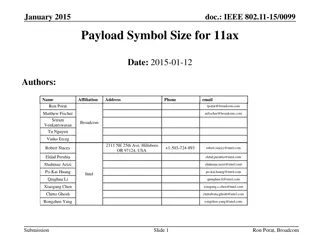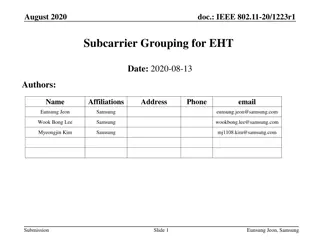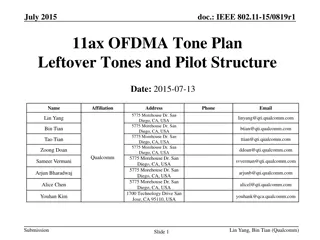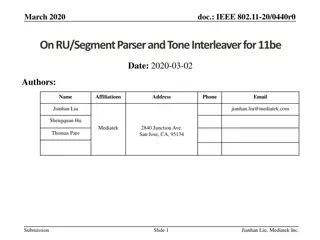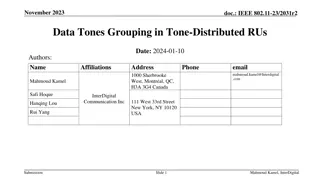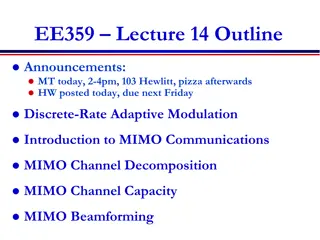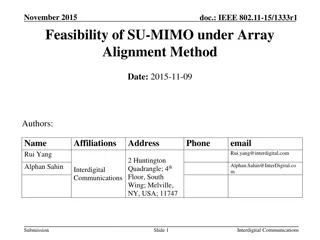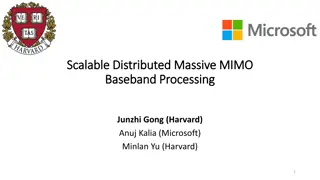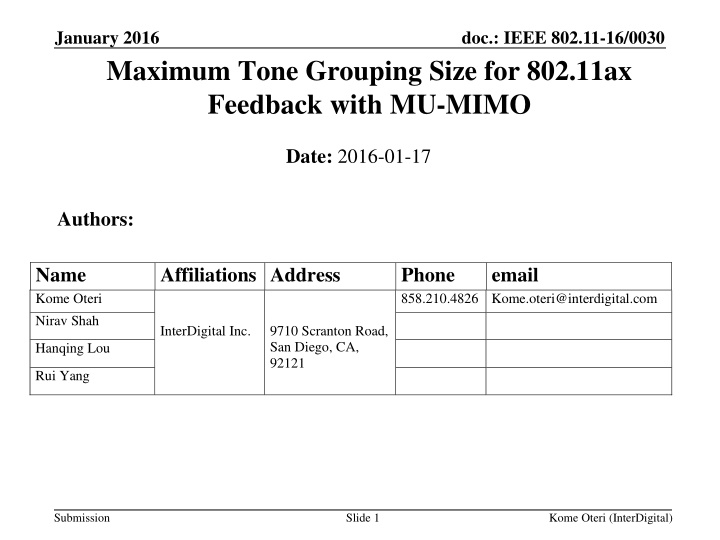
Maximum Tone Grouping Size in 802.11ax Networking
Investigating the optimal tone grouping size for feedback in 802.11ax technology, this document explores the implications of different Ng values on performance in SU/MU-MIMO scenarios. By analyzing the reduction in feedback overhead with larger Ng values, this study aims to identify the most efficient Ng parameters for Channel State Information (CSI) feedback. Discover how setting Ng to 16 can result in significant feedback data savings while maintaining comparable performance levels in various transmission scenarios. Considerations for MU-MIMO-OFDM(A) parameters are also raised for further exploration.
Download Presentation

Please find below an Image/Link to download the presentation.
The content on the website is provided AS IS for your information and personal use only. It may not be sold, licensed, or shared on other websites without obtaining consent from the author. If you encounter any issues during the download, it is possible that the publisher has removed the file from their server.
You are allowed to download the files provided on this website for personal or commercial use, subject to the condition that they are used lawfully. All files are the property of their respective owners.
The content on the website is provided AS IS for your information and personal use only. It may not be sold, licensed, or shared on other websites without obtaining consent from the author.
E N D
Presentation Transcript
January 2016 doc.: IEEE 802.11-16/0030 Maximum Tone Grouping Size for 802.11ax Feedback with MU-MIMO Date: 2016-01-17 Authors: Name Kome Oteri Nirav Shah Affiliations Address InterDigital Inc. Phone 858.210.4826 Kome.oteri@interdigital.com email 9710 Scranton Road, San Diego, CA, 92121 Hanqing Lou Rui Yang Submission Slide 1 Kome Oteri (InterDigital)
January 2016 doc.: IEEE 802.11-16/0030 Outline Introduction Maximum Tone Grouping in 802.11ax Link Level Simulation assumptions and results MU-MIMO Conclusion Submission Slide 2 Kome Oteri (InterDigital)
January 2016 doc.: IEEE 802.11-16/0030 Introduction The performance of SU-MIMO-OFDM(A) and MU-MIMO-OFDM(A) are a function of the grouping {Ng} and CSI quantization ??,?? of the feedback. The minimum value of Ng has been set in the SFD [1][2] : 802.11ax spec shall not support Ng = 1 for sounding feedback. NOTE The tone grouping factor, Ng is defined with respect to data tones of the HE PPDU. [PHY Motion 38, September 17, 2015, see [2]] This implies that the minimum tone grouping is Ng = 2. We will investigate the largest value of Ng for Channel State Information (CSI) feedback in 802.11ax. We quantify through analysis the significant reduction in feedback overhead that occurs with larger Ng We show through simulations that minimal performance loss is seen with larger Ng for some scenarios in SU/MU-MIMO-OFDM(A). Submission Slide 3 Kome Oteri (InterDigital)
January 2016 doc.: IEEE 802.11-16/0030 Maximum Tone Grouping in 802.11ax Tone grouping in 802.11ac Ng = 1 (312.5 kHz), 2 (625 kHz) and 4 (1250 kHz) Current tone grouping in 802.11ax Ng = 2 (156.25 kHz), and 4 (312.5 kHz) There are two options to increasing the maximum value of Ng Option 1: keep number of grouping parameters the same as 11ac (three values): 2 (156.25 kHz), 4 (312.5 kHz), 8 (625 kHz) Option 2: keep maximum frequency spacing the same as 11ac (four values): 2 (156.25 kHz), 4 (312.5 kHz), 8 (625 kHz), 16 (1250 kHz) Note: The grouping subfield in the VHT MIMO control field uses 2 bits to signal Ng with 1 value reserved. Thus, we may use up to 4 values without any changes in the field size. All we need to demonstrate is that a) there are substantial overhead savings and b) there are some scenarios in which either Ng set at 8 or 16 is beneficial. Submission Slide 4 Kome Oteri (InterDigital)
January 2016 doc.: IEEE 802.11-16/0030 Current Status In [5], we investigated the maximum tone grouping parameter {Ng} for 802.11ax We showed that setting the maximum tone grouping parameter {Ng} to 16 resulted in a large savings in feedback overhead. up to 70 % savings in feedback data when comparing Ng = 16 to Ng = 4 for 8 x 4 transmission and 242 tone RUs. We showed that that minimal PER performance differences are seen with Ng = 8 and 16 compared with Ng = 4 for channel B scenario in SU- MIMO-OFDMA We showed that that minimal PER performance differences are seen with Ng = 8 compared with Ng = 4 for channel D scenario in SU-MIMO- OFDMA We concluded that TGax should allow Ng = 2, 4, 8, or 16 for SU- MIMO-OFDMA What about MU-MIMO-OFDM(A) ? Should we have a different set of Ng parameters for MU-MIMO-OFDM(A) ? Submission Slide 5 Kome Oteri (InterDigital)
January 2016 doc.: IEEE 802.11-16/0030 Feedback Overhead Significant savings in feedback overhead as Ng increases even with frame exchange overhead Savings depend on feedback configuration: MU-MIMO/OFDMA, antenna configuration, MCS of feedback frame etc Overhead Calculation Assumptions Parameters UL-MU-OFDMA Feedback UL-MU-MIMO Feedback 234 48 4 0,4 0 8 4 4 44 Y 4 # of data subcarriers to report # of subcarriers to carry BF report frame # of UL BF report users MCS for BF feedback frame MCS for NDPA/Trigger Nt Nr N_sts,total Na (# of angles for V) MU exclusive BF report N_LTF for MU-MIMO 234 234 4 0,4 0 8 4 4 44 Y 4 Submission Slide 6 Kome Oteri (InterDigital)
January 2016 doc.: IEEE 802.11-16/0030 MU-MIMO-OFDM(A) Overhead Savings (1) Sounding with UL MU-ODMA Feedback [1] AP sends NDP-A, NDP and Trigger frame. STAs send UL MU-OFDMA feedback TxOP duration savings approximately the same as Bfreport feedback savings 8x4, MCS 0, UL MU-OFDMA with 4 users Ng Bfreport feedback savings with baseline Ng = 2 Compressed Beamforming frame (Bytes) Compressed Beamforming frame duration (us) TXOP duration (us): NDPA+NDP+TF+Bfreport+SIFS+ACK TXOP duration savings with baseline Ng = 2 (%) 2 4 8 16 0.00% 5302 28344 28692 0.00% 50.00% 2651 14200 14548 49.30% 75.00% 1326 7144 7492 73.89% 87.50% 663 3608 3956 86.21% 8x4, MCS 4, UL MU-OFDMA with 4 users Ng Bfreport feedback savings with baseline Ng = 2 Compressed Beamforming frame (Bytes) Compressed Beamforming frame duration (us) TXOP duration (us): NDPA+NDP+TF+Bfreport+SIFS+ACK TXOP duration savings with baseline Ng = 2 (%) 2 4 8 16 0.00% 5302 4776 5124 0.00% 50.00% 2651 2424 2772 45.90% 75.00% 1326 1240 1588 69.01% 87.50% 663 648 996 80.56% Submission Slide 7 Kome Oteri (InterDigital)
January 2016 doc.: IEEE 802.11-16/0030 MU-MIMO-OFDM(A) Overhead Savings (2) Sounding with UL MU-MIMO Feedback [1] AP sends NDP-A, NDP and Trigger frame. STAs send UL MU-MIMO feedback TxOP duration savings less than as Bfreport feedback savings but still significant 8x4, MCS 0, UL MU-MIMO with 4 users Ng Bfreport feedback savings with baseline Ng = 2 Compressed Beamforming frame (Bytes) Compressed Beamforming frame duration (us) TXOP duration (us): NDPA+NDP+TF+Bfreport+SIFS+ACK TXOP duration savings with baseline Ng = 2 (%) 2 4 8 16 0.00% 5302 5912 6260 0.00% 50.00% 2651 3016 3364 46.26% 75.00% 1326 1560 1908 69.52% 87.50% 663 840 1188 81.02% 8x4, MCS 4, UL MU-MIMO with 4 users Ng Bfreport feedback savings with baseline Ng = 2 Compressed Beamforming frame (Bytes) Compressed Beamforming frame duration (us) TXOP duration (us): NDPA+NDP+TF+Bfreport+SIFS+ACK TXOP duration savings with baseline Ng = 2 (%) 2 4 8 16 0.00% 5302 1080 1428 0.00% 50.00% 2651 600 948 33.61% 75.00% 1326 360 708 50.42% 87.50% 663 232 580 59.38% Submission Slide 8 Kome Oteri (InterDigital)
January 2016 doc.: IEEE 802.11-16/0030 Simulation Assumptions: MU-MIMO-OFDM 20 MHz DL MU-MIMO-OFDM system with 8 Tx AP, 1 Rx STA and 1 streams with 3 users 8 Tx AP, 2 Rx STA and 2 streams with 3 users Plot PER for 10000 realizations Feedback Model Feedback derived from real channel estimates based on sounding. Feedback delay = 50 msec, Compressed Feedback for MU-MIMO with ??= 9, and ??= 7 Precoding ZF MU-MIMO Submission Slide 9 Kome Oteri (InterDigital)
January 2016 doc.: IEEE 802.11-16/0030 Detailed Assumptions Parameter Value MCS 4 (16 QAM, 3/4) 7 (64 QAM, 5/6) Ntx / Nrx /Nss streams/ Nuser 8 / 1 /1 / 3 8 / 2 / 2 / 3 Number data [1] [234] Number tones in LTF 242 (4x) Channel Estimation Realistic (LS): ChEst Interpolation/smoothing [1] None CFO correction ideal Packet Size (Bytes) 1000 Channel [3] Indoor Channel B, D Coding BCC Timing/Frequency Sync Realistic Pilot Tracking ideal Submission Slide 10 Kome Oteri (InterDigital)
January 2016 doc.: IEEE 802.11-16/0030 Results for 1 stream, 3 users (Channel B, MCS4/7) Channel B: May use up to Ng =16 at MCS4 for Channel B May use up to Ng = 16 at MCS7 for channel B Assumption: < 1 dB of performance loss is acceptable Submission Slide 11 Kome Oteri (InterDigital)
January 2016 doc.: IEEE 802.11-16/0030 Results for 1 stream, 3 users (Channel D, MCS4/7) Channel D: May use up to Ng = 8 for MCS4 with Channel D May use up to Ng = 4 for MCS7 with Channel D Submission Slide 12 Kome Oteri (InterDigital)
January 2016 doc.: IEEE 802.11-16/0030 Results for 2 streams, 3 users (Channel B, MCS4/7) Channel B: May use up to Ng =16 at MCS4 for Channel B May use up to Ng = 8 at MCS7 for channel B Submission Slide 13 Kome Oteri (InterDigital)
January 2016 doc.: IEEE 802.11-16/0030 Results for 2 streams, 3 users (Channel D, MCS4/7) Channel D: May use up to Ng = 4 for MCS4 with Channel D May use up to Ng = 2 for MCS7 with Channel D Submission Slide 14 Kome Oteri (InterDigital)
January 2016 doc.: IEEE 802.11-16/0030 Conclusions We investigate the maximum tone grouping parameter {Ng} for 802.11ax For low delay spread channels Ng = 16 is viable for low MCS transmission. For high delay spread channels or high MCS, Ng = 16 is not usable Conclusion: there are MU-MIMO configurations that may use up to Ng = 16 as the tone grouping parameter. TGax should allow Ng = 2, 4, 8, or 16 for SU-MIMO-OFDMA and MU- MIMO Submission Slide 15 Kome Oteri (InterDigital)
January 2016 doc.: IEEE 802.11-16/0030 Straw Poll #1 Do you agree to add the following to Section 7.3 of the Tgax SFD ? 802.11ax spec shall support Ng = 2, 4, or 8 for sounding feedback with SU-MIMO-OFDM(A). NOTE The tone grouping factor, Ng is defined with respect to data tones of the HE PPDU. Y/N/A Submission Slide 16 Kome Oteri (InterDigital)
January 2016 doc.: IEEE 802.11-16/0030 Straw Poll #2 Do you agree to add the following to Section 7.3 of the Tgax SFD ? 802.11ax spec shall support Ng = 2, 4, or 8 for sounding feedback with MU-MIMO-OFDM(A). NOTE The tone grouping factor, Ng is defined with respect to data tones of the HE PPDU. Y/N/A Submission Slide 17 Kome Oteri (InterDigital)
January 2016 doc.: IEEE 802.11-16/0030 Straw Poll #3 Do you agree to add the following to Section 7.3 of the Tgax SFD ? 802.11ax spec shall support Ng = 16 for sounding feedback with SU- MIMO-OFDM(A). NOTE The tone grouping factor, Ng is defined with respect to data tones of the HE PPDU. Y/N/A Submission Slide 18 Kome Oteri (InterDigital)
January 2016 doc.: IEEE 802.11-16/0030 Straw Poll #4 Do you agree to add the following to Section 7.3 of the Tgax SFD ? 802.11ax spec shall support Ng = 16 for sounding feedback with MU-MIMO-OFDM(A). NOTE The tone grouping factor, Ng is defined with respect to data tones of the HE PPDU. Y/N/A Submission Slide 19 Kome Oteri (InterDigital)
January 2016 doc.: IEEE 802.11-16/0030 References 1. 2. 3. 4. 11-15-0132-09-00ax-spec-framework 11-15-1071-02-00ax-tone-grouping-factors-and-ndp-format-for-802-11ax 11-15-0330-05-00ax-ofdma-numerology-and-structure Eldad Perahia, Robert Stacey; Next Generation Wireless LANs, 802.11n and 802.11ac,, Cambridge University Press, 2013, Online ISBN:9781139061407, ISBN:9781107016767 11-15-1320-02-00ax-maximum-tone-grouping-size-for-802-11ax-feedback 5. Submission Slide 20 Kome Oteri (InterDigital)



